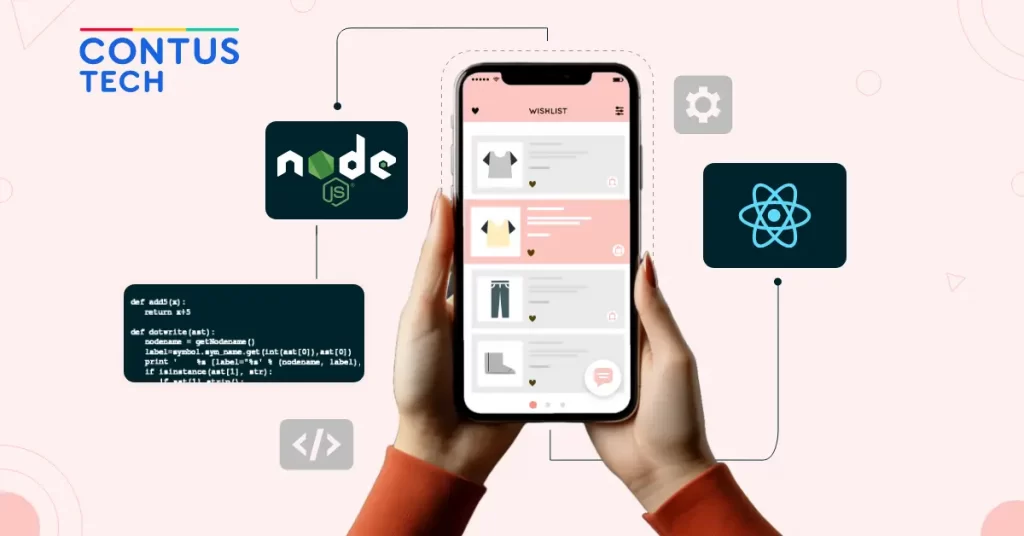Create a Full Stack Web Application Using React & Node.js in 2025

When considering today’s state — technology is a playground where new applications are introduced every single day. One exciting thing for developers is building full stack web applications.
Just picture this — you are building a house from scratch – you need both strong bricks (like Node.js) as well as good interiors (like React) to make it really awesome!
So, what is Node.js and React? Well, Node.js can be considered as a toolbox for building the backend part, the part of the web app that does all the heavy lifting that you might not be aware of.
In simpler terms, Node.js helps you make websites faster and more reliable.
Now, let us put some spotlight on this term i.e. React. Here, consider you are decorating your house with all the possible light combinations and paints.
That’s what React does — it helps you create that attractiveness that your users see and interact with on the front end web app.
Now the main question arises —- Why use both (Node.js and React) together? It is like combining chocolate and honey/butter – By the way, they are great when we have them separately, but together, they make something even more enjoyable to our taste buds!
By using Node.js for the backend and React for the frontend, you can build a complete full stack web application that is fast, scalable, and much more reliable.
With this being clear, let us know the advantages of building a full stack application using React and Node.js.
Table of Contents
Why Develop A Full-Stack Application Using React and Node.js?
Creating a feature-rich full stack web application necessitates the utilization of React and Node.js—a pairing that has the capability to unlock a number of benefits.
In this section let us look into the compelling reasons why developing a full stack application using React and Node.js is super beneficial in 2025. Let’s get started!
1. Scalability
In the wave of web development, scalability stands as the guiding light who is into full stack development services. With React and Node.js, scalability takes a different shape from a feature into a robust pillar, ensuring that your web application can witness unprecedented growth along with agility.
Guess what? Scalability isn’t just about handling more users — it is about future-proofing your creation. With React’s lightning-fast rendering and Node.js’s non-blocking architecture, your full stack web application becomes a strong building that is hard to break from external forces.
But wait—there’s more! Scalability isn’t just about handling volume; it’s about responsiveness too. With React and Node.js on your side, your application can go through the bustling thoroughfares of user interactions with grace and finesse.
2. Fast Development
When we consider time, React and Node.js emerge together to give their best, accelerating the pace of Web app development. This duo further creates a symphony of efficiency, converting your ideas from conception to fruition at breakneck speed.
Nevertheless, with their robust ecosystem of libraries and frameworks, you will find yourself sprinting towards the finish line, leaving competitors in the dust. But hold on—there’s more to fast development than just speed. Efficiency is the name of the game, and React and Node.js are the masters of optimization.
3. Organized Process
With React and Node.js on your side, a better-organized process becomes second nature. Indeed, organization isn’t just about pages of code—it’s about clarity too.
Yes, it is! With React’s declarative syntax and Node.js’s event-driven pattern, your codebase becomes an assortment of lucidity, where every line tells a story and every function works concurrently.
Apart from the organized process, there is more to the organization. Collaboration is a pretty much important factor of development, and React and Node.js are the channels through which ideas flow freely. From version control to code reviews, every aspect of the web app development process is made with precision.
4. Single Language for Front-end and Back-end
With React for the front end activities and Node.js for the back-end developments, JavaScript emerges as the undisputed potentate, reigning over a unified ecosystem. In fact, JavaScript provides unparalleled control over every facet of your application, from the front end to the back end and beyond.
But hold on—With Reach and Node.js, there is more apart from the above. From shared data structures to unified tooling, every aspect of your web app development environment is harmonized for maximum efficiency, ensuring that your codebase is as stable as possible.
How To Build a Full Stack Web App with React and Node.js?
Building a full-stack web app may look difficult at once, but it is nothing to worry about! With the right steps in mind, you will be able to build a full stack web application in no time. With this being clear, let us look into the 7 simple steps to build a full stack web application using React and Node.js.
Why Choose Node.js and React?
Before start reading the steps, let’s understand why these both technologies were a great choice for you;-
- Node.js — known for its fast performance and ability to handle multiple tasks simultaneously. It’s built on Chrome’s V8 JavaScript engine, making it efficient and scalable.
- React — popular frontend library developed by Facebook. It allows developers to build user interfaces with reusable components, making the development process faster and more organized.
1. Set Up Your Development Environment
Before you start thinking about building a full stack web app, you need to set up the rock-solid basement. As mentioned in the heading, start by setting up your development environment. Whether you prefer a single laptop or a workspace with dual monitors.
First things first, you need to set up your development environment. Here’s what you’ll need:
- Node.js: This allows you to run JavaScript on the server side.
- npm: A package manager that helps you manage project dependencies.
- Code Editor: A tool like Visual Studio Code, which offers various extensions to enhance productivity.
2. Building your project
Read this—once your development environment is ready, it’s time to launch your project ie. You will build a full stack web application. Start your business with a plan and summon creativity and innovation to your side. Yes, you read that right!
Let’s start by creating a directory for your project. This includes developing the project master plan and developing the necessary infrastructure. Starting with a clean, organized process helps manage the project as it grows.
Create a project directory: Organize your files from scratch to avoid clutter.
- Initialize npm: This step sets up a file to manage all your project dependencies and script usage.
- Creating Dependencies: Start by installing the necessary tools and libraries in your project.
3. Configure the Backend with Node.js
Believe it or not, the backend is the important part of your full stack web application, making its every move absolutely precise.
You can easily configure a server with the Node.js web framework. This design simplifies the process of processing HTTP requests and developing APIs, making it a good choice for backend development.
- Configure the server: Configure your server to handle different routes and endpoints.
- Middleware Integration: Use middleware to handle requests, responses, and errors.
- Define routes: Establish endpoints for your application to monitor how your server responds to requests.
4. Set Up the Frontend with React
Next, we create a React frontend. React actually helps you build user interfaces by breaking them down into reusable parts. This not only accelerates development but also enables better monitoring of the code.
- Build a React App: Use the boilerplate framework to quickly scaffold a new React project.
- Component Structure: Structure your UI with component-based architecture, breaking down the interface into smaller, more reusable chunks.
- State control: Properly manage state in your application.
- Styling: Apply styles to your components to make your UI visually appealing and easy to use.
5. Connecting Frontend and Backend
To connect your React app with the server, you’ll need to set up a method for the two to communicate. This allows the React frontend to communicate with the backend server, enabling seamless data exchange.
- Proxy Configuration: Set up a proxy in the React app to forward API requests to the server.
- API Calls: Make HTTP requests from the React frontend to the backend.
- Data Handling: Ensure smooth data flow between frontend and backend, handling responses and errors gracefully.
6. Building a Simple API
Creating a simple API endpoint is the next step. This involves setting up routes and fetching data from the backend in your React app. This interaction forms the core of a full-stack application, allowing data to flow between the server and the client.
- Define API Endpoints: Set up routes to handle API requests.
- Fetch Data in React: Make API calls from your React components to fetch data from the backend.
- Handle Asynchronous Operations: Manage asynchronous operations to ensure your application handles data fetching and error states effectively.
7. Deploying Your App
Once you’re happy with your app, it’s time to deploy. There are many options available for deployment, but a common choice is using services for the backend and frontend. These platforms offer easy setup and scalability, ensuring your app is accessible to users.
- Backend Deployment: Deploy your server on a platform that offers easy setup and scalability.
- Frontend Deployment: Deploy your React frontend on a service that connects your Git repository and automates the deployment process.
- Environment Variables: Securely manage sensitive information like API keys and database credentials.
- Continuous Deployment: Set up pipelines to automatically deploy changes whenever you push updates to your repository.
Building a full-stack web app with Node.js and React is an excellent opportunity to learn both backend and frontend development. However, tackling this alone can be challenging.
You can seek help or develop your app by partnering with Contus Tech, a full-stack development company renowned for its expertise in delivering innovative digital solutions.
With a team of skilled professionals and a proven track record of successful projects, Contus Tech can provide the support and resources you need to bring your vision to life.
Wrapping Up
In the end, all we would like to say is building a full stack web app using React and Node.js opens up endless possibilities. From scalability to user engagement, every step in the process contributes to creating a seamless web application experience.
Looking to bring your vision of a full-stack web app into reality? Then consider CONTUS Tech for top-notch full-stack app development. With the expertise and dedication of 300+ full stack web developers, your project is in capable hands. When you looking for full stack developers for hire from our talented team, you ensure success at every turn.
If You Are Looking to Build a Full Stack Web Application. Contact Us To Start Your Project Within The Next Few Hours.
Frequently Asked Questions (FAQs):
What is a Full Stack Web App?
A full stack web app combines the front-end user interface (built with HTML, CSS, JavaScript) with the back-end server-side application (databases, APIs, etc). It’s an entire multi-layered web app versus just the front or back pieces.
How to Create a Full Stack Application?
To create a full stack application, you need to plan out the app flow/architecture first. Then set up the front-end with HTML/CSS/JS frameworks like React or Angular. Integrate that with a back-end language like Ruby, Python, Node.js and set up databases/APIs. Connect the layers through APIs and HTTP requests. Finally, test and deploy the full stack to hosting.
What Technologies are Used to Create a Full Stack Web Application?
The technologies used to create a full stack web application commonly include HTML/CSS/JavaScript on the front-end, React or Angular frameworks, Node.js for server-side/back-end, databases like MongoDB or PostgreSQL, HTTP for communication, hosting services like AWS or Heroku, and more.
Can I Use Node.js for Both Frontend and Backend Development?
Yes, Node.js can actually be used for both front-end and back-end development, making it a true full stack runtime environment. While most developers use Node for the back-end server-side code, you can also run Node for front-end code and user interfaces by leveraging libraries like React.
How do you build and deploy a full-stack React app?
To build and deploy a full-stack React app, set up React with create-react-app for the front-end UI. Use a back-end like Node/Express to build out the server and API endpoints. Connect the React front-end to the Node API through HTTP requests. Add databases, authentication, etc. Test locally then deploy the full-stack app to a hosting service like Heroku or AWS.




Is it necessary to use a database with Node.js and React, or can they work independently?
Hey, I have a question, are there any best practices for integrating React with a Node.js backend? Please reply
Great article! But can you explain how React and Node.js help with maintaining and updating the app over time?
Building a full-stack app looks challenging but doable. Your step-by-step breakdown is exactly what I needed to start on this journey
Great blog! Could you elaborate on how Node.js handles real-time data processing and why it’s advantageous?
Sure Clarence, Node.js excels in real-time data processing due to its non-blocking I/O model and event-driven architecture. This allows it to handle multiple simultaneous connections efficiently, making it ideal for real-time applications like chat systems or live data feeds.
I never realized how important an organized process is in development. Thanks for highlighting this!
Organization is key to smooth development! React’s declarative syntax and Node.js’s event-driven pattern make managing code much easier.
I appreciate the detailed explanation of scalability and how React and Node.js contribute to it. Very insightful!
Glad you found the scalability insights helpful! React’s fast rendering and Node.js’s non-blocking architecture do make a great team for handling growth.
This blog perfectly captures the essence of using Node.js and React together. The analogy with building a house is spot on!
Monitoring and maintaining a full stack web app built with Node.js and React is hassle-free. I can keep the app running smoothly with regular updates. Long-term maintenance is simplified.
Very Informative blog!
Developing features with Node.js and React is a breeze. The ecosystem of libraries and frameworks speeds up the process significantly. Innovation happens quickly and effectively.
Building a full stack web app with Node.js and React is like creating a masterpiece. Each component fits perfectly, resulting in a high-quality application. I enjoy the creative freedom it offers.
One of the best things about using Node.js and React is the single language for both frontend and backend. JavaScript rules the development process! This unification simplifies everything.
Node.js handles the heavy lifting in the backend while React makes the frontend attractive and interactive. This duo is unbeatable.
Combining Node.js and React for a full stack application is like using the best materials for a house. You get a strong foundation and a beautiful design.
This blog serves as a comprehensive roadmap for anyone looking to embark on the journey of building a full stack web app. From planning and design to development and deployment, it covers all the essential steps necessary for success.
I appreciate the real-world examples and case studies shared in this blog. Seeing how full stack web apps are built in practice helps solidify the concepts discussed and provides inspiration for future projects.
The step-by-step guide to deploying a full stack web app is incredibly valuable. Deployment can be a daunting task for many developers, but this blog breaks it down into manageable chunks, making it easier to get your app up and running in no time.
I found the section on integrating React with Node.js to be particularly insightful. Understanding how these technologies work together is key to building a seamless full stack web app, and this blog does an excellent job of explaining the integration process.
I appreciate how you highlight the importance of planning and designing your full stack web app before diving into development. As the saying goes, “failing to plan is planning to fail,” and this advice holds true in the world of software development.
The tips for structuring your full stack project effectively are spot on. Organising your codebase in a logical and maintainable way is essential for long-term success, and this blog provides practical guidance on how to achieve that.
In the section on setting up the development environment is particularly useful for me to getting started with full stack development. Very well-configured environment is crucial for a smooth workflow, and you covered all the essentials aspects.
As a seasoned full stack developer, I’m always on the look for a new technologies to enhance my skill set. your insights into building a full stack web app with React and Node.js, making it more easier for developers at any level.
I was searching for a full stack web app development, and this blog couldn’t have come at a perfect time. The detailed explanations and code snippets make it easy for beginners like me to understand the fundamentals of React and Node.js. Thank You!
You walkthrough of the process of building a full stack web app using React and Node.js. As someone new to full stack development, I found the step-by-step instructions easy to follow and incredibly helpful.